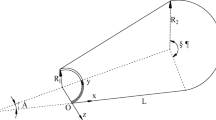Abstract
In order to increase surface quality and material removal efficiency, a 2-DOF vibration-assisted polishing device driven by piezoelectric actuators (PZTs) was developed. The matrix-based compliance modeling (MCM) method was used to calculate stiffness, and Lagrange’s method was used to analyze the natural frequency of the device. To make the 2-DOF vibration-assisted polishing device achieve better performance, the dimensions of the device were optimized by the Whale optimization algorithm (WOA). Meanwhile, FEA was used in simulation and analysis of the device. The open-loop testing results show that the 2-DOF vibration-assisted polishing device has the characteristics of large stroke and high resolution. The polishing experimental results show that vibration-assisted polishing can improve the surface quality and material removal rate.

























Similar content being viewed by others
References
Tsegaw AA, Shiou FJ, Lin SP (2015) Ultra-precision polishing of N-Bk7 using an innovative self-propelled abrasive fluid multi-jet polishing tool. Mach Sci Technol 19(2):262–285
Lee Y (2011) Evaluating subsurface damage in optical glasses. J Eur Opt Soc-Rapid Publ 6:11001
Li Y, Huang H, Xie R (2010) A method for evaluating subsurface damage in optical glass. Opt Express 18(16):17180–17186
Agarwal S, Rao PV (2010) Grinding characteristics, material removal and damage formation mechanisms in high removal rate grinding of silicon carbide. Int J Mach Tools Manuf 50(12):1077–1087
Yu T, Li H, Wang W (2016) Experimental investigation on grinding characteristics of optical glass BK7: with special emphasis on the effects of machining parameters. Int J Adv Manuf Technol 82(5–8):1405–1419
Deng H, Ueda M, Yamamura K (2014) Characterization of 4H-SiC (0001) surface processed by plasma-assisted polishing. Int J Adv Manuf Technol 72(1–4):1–7
Lin YC, Kao CH (2005) A study on surface polishing of SiC with a tribochemical reaction mechanism. Int J Adv Manuf Technol 25(1–2):33–40
Lin B, Jiang XM, Cao ZC (2019) Development and theoretical analysis of novel center-inlet computer-controlled polishing process for high-efficiency polishing of optical surfaces. Robot Comput Integr Manuf 59:1–12
Jones RA (1986) Computer-controlled optical surfacing with orbital tool motion. Opt Eng 25(6):256785
Suzuki H, Moriwaki T, Okino T (2006) Development of ultrasonic vibration assisted polishing machine for micro aspheric die and mold. CIRP Ann 55(1):385–388
Suzuki H, Hamada S, Okino T (2010) Ultraprecision finishing of micro-aspheric surface by ultrasonic two-axis vibration assisted polishing. CIRP Ann 59(1):347–350
Zhang Z, Yang X, Zheng L (2017) High-performance grinding of a 2-m scale silicon carbide mirror blank for the space-based telescope. Int J Adv Manuf Technol 89(1–4):463–473
Zhao Q, Sun Z, Guo B (2016) Material removal mechanism in ultrasonic vibration assisted polishing of micro cylindrical surface on SiC. Int J Mach Tools Manuf 103:28–39
Lin J, Lu H, Gu Y (2019) A new vibration device applied for two-dimensional ultrasonic polishing of biomaterials. IEEE Access 7:92838–92849
Gu Y, Zhou Y, Lin J (2019) Analytical prediction of subsurface damages and surface quality in vibration-assisted polishing process of silicon carbide ceramics. Materials 12(10):1690
Chee SK, Suzuki H, Okada M (2011) Precision polishing of micro mold by using piezoelectric actuator incorporated with mechanical amplitude magnified mechanism. Trans Tech Publ Conf Adv Mater Res 325:470–475
Chee SK, Suzuki H, Uehara J (2012) Preliminary studies for precision polishing of micro structured mold by using three-dimensional low frequency vibration utilizing piezoelectric actuator incorporated with mechanical amplitude magnified mechanism. Trans Tech Publ Conf Adv Mater Res 565:231–236
Chee SK, Suzuki H, Uehara J (2013) A low contact force polishing system for micro molds that utilizes 2-dimensional low frequency vibrations (2DLFV) with piezoelectric actuators (PZT) and a mechanical transformer mechanism. IJAT 7(1):71–82
Zhang P, Guo X, Guan Z (2011) Research on ellipse vibration grinding finishing technology. IEEE Proc Conf Int Conf Electron Mech Eng Inf Technol 3:1160–1163
Guo J, Suzuki H (2018) Effects of process parameters on material removal in vibration-assisted polishing of micro-optic mold. Micromachines 9(7):349
Gu Y, Chen X, Lin J (2018) Vibration-assisted roll-type polishing system based on compliant micro-motion stage. Micromachines 9(10):499
Selig JM, Ding X (2009) A screw theory of timoshenko beams. J Appl Mech 76(3):031003
Koseki Y, Tanikawa T, Koyachi N (2002) Kinematic analysis of a translational 3-dof micro-parallel mechanism using the matrix method. Adv Robot 16(3):251–254
Paros JM, Weisbord L (1965) How to design flexure hinges. Mach Des 37:151–156
Chau NL, Dang VA, Le HG (2017) Robust parameter design and analysis of a leaf compliant joint for micropositioning systems. Arab J Sci Eng 42(11):4811–4823
Tang H, Li YM, Huang JM (2012) Design and assessment of a flexure-based 2-DOF micromanipulator for automatic cell micro-injection. Trans Tech Publ Conf Adv Mater Res 457:445–448
Ho NL, Dao TP, Chau NL (2018) Multi-objective optimization design of a compliant microgripper based on hybrid teaching learning-based optimization algorithm. Microsyst Technol
Ho NL, Dao TP, Le HG (2019) Optimal design of a compliant microgripper for assemble system of cell phone vibration motor using a hybrid approach of ANFIS and Jaya. Arab J Sci Eng 44(2):1205–1220
Mirjalili S, Lewis A (2016) The whale optimization algorithm. Adv Eng Softw 95:51–67
Ma F, Huang H, Cui C (2020) Biomachining properties of various metals by microorganisms. J Mater Process Technol 278:116512
Funding
This work is supported by Joint Funds of the National Natural Science of Foundation of China (Grant No. U19A20104), the Micro-Nano and Ultra-Precision Key Laboratory of Jilin Province (Grant Nos. 20140622008JC), and Science and Technology Development Projects of Jilin Province (Grant Nos. 20190201254JC and 20190302065GX).
Author information
Authors and Affiliations
Corresponding author
Additional information
Publisher’s note
Springer Nature remains neutral with regard to jurisdictional claims in published maps and institutional affiliations.
Rights and permissions
About this article
Cite this article
Gu, Y., Duan, X., Lin, J. et al. Design, analysis, and testing of a novel 2-DOF vibration-assisted polishing device driven by the piezoelectric actuators. Int J Adv Manuf Technol 111, 471–493 (2020). https://doi.org/10.1007/s00170-020-06043-w
Received:
Accepted:
Published:
Issue Date:
DOI: https://doi.org/10.1007/s00170-020-06043-w




